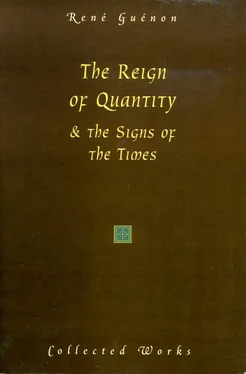The second observation is connected with the descending direction of the cyclical movement, insofar as this movement is regarded as the chronological expression of a process of manifestation that implies a gradual separation from the principle, a point we have referred to often enough that further insistence on it can be dispensed with. It is only mentioned again here because, taken in connection with what has just been said, it gives rise to a spatial analogy of considerable interest. The increase in the speed of events, as the end of the cycle draws near, can be compared to the acceleration that takes place in the fall of heavy bodies: the course of the development of the present humanity closely resembles the movement of a mobile body running down a slope and going faster as it approaches the bottom; and even though certain reactions operating in a contrary sense complicate the matter to some extent (within the limits of the possibility of such reactions), nonetheless this comparison gives a very accurate picture of the cyclical movement looked at in a general way.
Here, then, is a third and final observation. The descending movement of manifestation, and consequently that of the cycle of which it is an expression, takes place away from the positive or essential pole of existence toward its negative or substantial pole, and the result is that all things must progressively take on a decreasingly qualitative and an increasingly quantitative aspect; and that is why the last period of the cycle must show a very special tendency toward the establishment of a ‘reign of quantity’. Moreover, the statement that this must be so for all things does not merely imply that it must be so as seen from a human point of view, but also that a real modification of the ‘environment’ itself is involved. Each period of the history of humanity corresponds specifically to a determinate ‘cosmic moment’, so that there must necessarily be a constant correlation between the state of the world itself, or of what is called ‘nature’ in the usual sense of the word and more especially of the terrestrial environment, and the state of mankind, whose existence is evidently conditioned by that environment. It may be added that total ignorance of such cosmic modifications is not least among the causes of the incomprehension of modern science whenever anything beyond certain limits is concerned; itself born of the very special conditions of the present period, this science is all too obviously incapable of conceiving other and different conditions, incapable even of the mere admission that anything of the kind could exist; thus the point of view that constitutes the definition of modern science establishes ‘barriers’ in time, which it is as impossible for science to break down as it is for a short-sighted person to see clearly beyond a certain distance; a true ‘intellectual myopia’ is indeed thoroughly characteristic in all respects of the modern and ‘scientistic’ mentality. Later developments of this theme will lead to a better understanding of the nature of these modifications of the environment, which can only be alluded to now in quite a general way; but it may already have occurred to the reader that many things nowadays regarded as ‘fabulous’ were not at all so for the ancients, and even that they may still not be so for those who have retained, not only the possession of certain aspects of traditional knowledge, but also an outlook that allows them to reconstitute the shape of a ‘lost world’, as well as to foresee, at least in its broad outlines, what will be the shape of a future world. For no other reason than that manifestation is ruled by cyclical laws, the past and the future are in analogical correspondence, so much so that, whatever the ordinary person may think, previsions of this kind have not really any ‘divinatory’ character whatever, but are founded entirely on what have been called the qualitative determinations of time.
6
The Principle of Individuation
The natures of space and time have now been dealt with adequately for the purpose in view, but it is necessary to return to the subject of ‘matter’ in order to examine a question not so far mentioned, in such a way as to shed a fresh light on certain aspects of the modern world. The scholastics looked on materia as constituting the principium individuationis ; what was their reason for looking at things in that way, and how far was it justified? In order to understand what is involved in this question it is sufficient, without in any way going beyond the limits of our world (for no principle is here involved of a transcendent order with respect to this world) to envisage the relation of individuals to species; in this relation species is on the side of ‘form’ or essence, and individuals, or more exactly that which distinguishes individuals of the same species one from another, are on the side of ‘matter’ or substance. [26] It should be pointed out that there is a difficulty in this connection, at least in appearance: in the hierarchy of kinds, if one considers the relation of one particular kind to a second less general kind, which is as it were a species in relation to the first, the first plays the part of ‘matter’ and the second the part of ‘form’; thus at first sight the relation appears to apply in a reverse direction, though actually it is not comparable to the relation of species to individuals; moreover, it is envisaged from a purely logical point of view, as if it were the relation of a subject and an attribute, the subject corresponding to the designation of the kind and the attribute to that of the ‘specific difference’.
There is nothing surprising in this, bearing in mind what has been said above about the meaning of the word εἶδος, which is at once both ‘form’ and ‘species’, and about the purely qualitative character of the latter; but the point needs some further elucidation, particularly, in the first place, in order to eliminate various terminological uncertainties likely to arise.
It has already been explained why the word ‘matter’ can give rise to misunderstandings; the word ‘form’ is perhaps even more liable to do so, because its usual meaning is quite different from that which it bears in scholastic language; it was used in its usual meaning when the consideration of form in geometry was alluded to above, but if scholastic language had been used instead, it would have been necessary to say ‘figure’ and not ‘form’; to have done so would however have been unduly contrary to established usage, of which account must inevitably be taken if misunderstanding is to be avoided, and that is why the word ‘form’ is always used in this book in its ordinary meaning, except when it is used with particular reference to scholasticism. For instance, the word is used in its ordinary meaning in the statement that, of all the conditions of a state of existence, form is the one that specifically characterizes that state as individual; it goes without saying that form in this sense must in no way be conceived as endowed with a spatial character, for it is so endowed only in our world, because it is there combined with another condition, namely space, and space belongs to the domain of corporeal manifestation alone. But this question then arises: does not form thus understood, rather than ‘matter’ (or if preferred, quantity), represent the true ‘principle of individuation’, since individuals are what they are by virtue of the fact that they are conditioned by form? So stated, this question represents a misunderstanding of what the scholastics in fact mean when they speak of a ‘principle of individuation’; in no sense are they referring to that which defines a state of existence as an individual state, for they seem never to have attained to a conception quite of that order; and in any case, from this point of view, species itself must be regarded as being within the individual order, for it is in no way transcendent with regard to the state so defined. The same point can be made in another way, by making use of the geometrical representation described elsewhere, and in that case, the whole hierarchy of kinds must be envisaged as extending horizontally and not vertically.
Читать дальше











